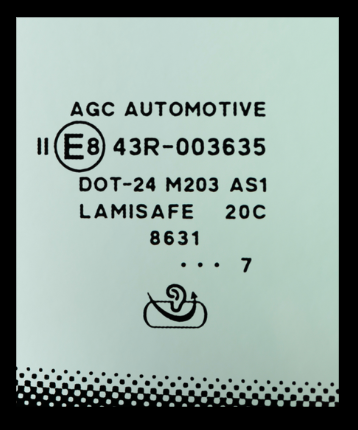Laminated Glass Escape Challenges Explained
It’s important to know the type of glass your car has before an emergency situation arises. Tempered or Laminated Windows - Which Type of Glass Do You Have?

Tempered vs. Laminated Windows: Which Type of Glass Do You Have?
It’s important to know the type of glass your car has before an emergency situation arises. To determine whether your car windows are tempered or laminated, check the corners of the windows for a logo. This logo will indicate whether the glass is "tempered" or "laminated," however, automakers may use different terms. Some tempered glass might be labeled as "Templex" or "Temperlite." Some laminated glass may be labeled “LAMISAFE”, "laminated” or “EPG” (Enhanced Protective Glass).
If you’re uncertain, refer to your vehicle’s manual or contact the dealership to confirm the type of windows installed.
NHTSA Mandate Creates Unintended Risk:
-
Ejection Mitigation Mandate
Read Find NHTSA RuleIn 2011, the Code of Federal Regulations was updated to include FMVSS 226 – Ejection Mitigation. This mandate from the NHTSA was established to enhance driver safety during crashes. Since 2017, automakers in the United States have been required to implement methods to reduce the likelihood of occupant ejection.Today, 1 in 3 cars are manufactured with laminated front and side windows, creating a significant risk of deadly entrapment.
-
Risk of Entrapment
AAA Report PDFThe Department of Transportation mandate aims to keep drivers safely inside their vehicles during a motor vehicle accident. However, it complicates the ability of first responders to take immediate action at the scene without the ability to use traditional window punches, breakers, or powered glass-cutting tools. According to a 2019 AAA Report, traditional punch tools are ineffective against laminated glass. An issue not widely known by first responders or the average driver.
-
Be Ready for Unexpected Emergencies
Buy NowLIFELINE™ has long recognized the critical importance of providing first responders with the best extrication tools possible because we understand how this mandate impacts their ability to react quickly and effectively in the field.
LIFELINE Rescue Tools are the only handheld consumer device capable of cutting laminated glass. We're proud to offer it to the public to bridge the dangerous gap in both personal and professional safety.
FAQ's
Why do I need a rescue tool?
NHTSA’s FMVSS 226 has driven automakers to use laminated glass in side windows to prevent ejections in crashes. Unlike tempered glass, laminated glass resists standard window breakers, risking entrapment during emergencies. A 2019 AAA study found that typical consumer tools fail against laminated glass, a challenge for both drivers and first responders. LIFELINE Rescue Tools are designed to cut through laminated glass quickly, ensuring safe escape or rescue when every second counts.
How do I know if my car has laminated glass?
Check the lower corner of your car’s side windows for a label. Look for “Laminated,” “LAMI,” or “AS1/AS2” without “Tempered” or “T.” If absent, inspect the edge for a plastic interlayer. Many vehicles since 2013 use laminated side glass due to safety regulations. Unsure? Check your owner’s manual or visit AAA - Know Your Vehicle’s Glass Type" for more information>>.
LIFELINE Rescue Tools ensure you’re prepared for any glass type in an emergency.
Have LIFELINE Rescue Tools been tested?
LIFELINE Rescue Tools have been rigorously tested in the field by active-duty first responders around the globe. Thousands of these tools are currently utilized by police officers, firefighters, and military personnel, supported by testimonials from both self-rescues and rescues of victims performed by these responders. Our STEALTH self-rescue tool is trusted by 3,300 New York State Troopers, who have recently been equipped with our LIFELINE STEALTH™.
Are the rescue tools easy to use?
LIFELINE rescue tools are designed for emergency situations only. While these tools are easy to use, we strongly recommend all users to watch our training video. It highlights best practices and cutting techniques, such as maintaining a firm grip, effectively creating a starter hole, and utilizing the entire length of the blade with strong pressure. These factors are essential for ensuring the speed of escape.